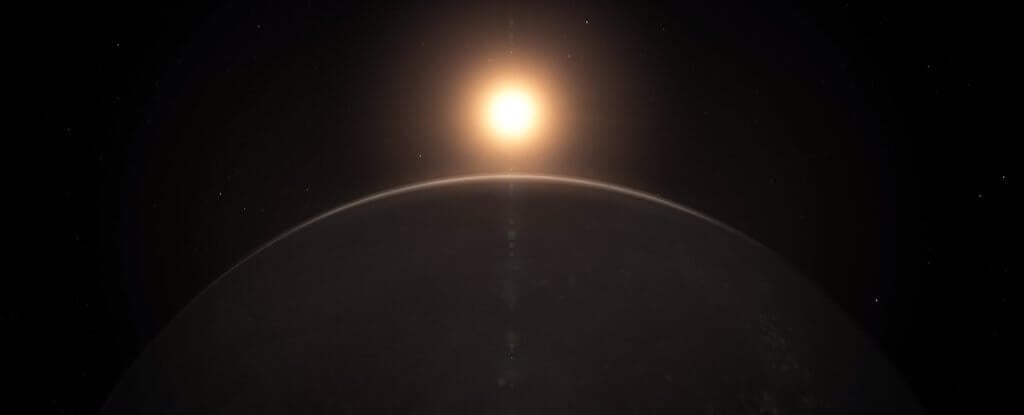
Only 11 light years from the Solar system astronomers have discovered a new earth-like planet with a climate that can be expected to come to life. It should be noted that after Proxima b is the second closest exoplanet to us to have such a feature. The site is called Ross 128 b and located in the habitable zone of its star, a red dwarf Ross 128. Exoplanets detected by the receiver HARPS ESO Observatory La Silla in Chile. And for her discovery scientist took a lot of time.
“We started to monitor the star from July 2005,” commented the portal ScienceAlert astronomer Nicolas Astudillo-DEFRA from the Geneva Observatory.
“In 2013, our observations become more frequent, and only later, 157 of these observations we were able to catch a signal strong enough to be able to infer the presence there of the planet.”

She has a mass of approximately 1.35 times larger than the earth. From this we can conclude that it is solid as a gaseous planet, at least those that we know, as a rule, represented by these giants. Another sign that indicates the solid nature of the Ross 128 b, is that it is relatively close to their star – about 20 times closer than Earth is to the Sun, so its orbital period is 9.9 days.
Why it could be potentially suitable for life? It’s simple: it’s not too hot and not too cold. The star Ross 128 is a dim red dwarf. Emits less radiation than our Sun. According to preliminary calculations, the planet receives only 1.38 times more energy compared to the Ground. In addition, the activity of the red dwarf Ross 128, scientists say, is several times lower compared to the average activity of other red dwarfs, for example, Proxima Centauri. In other words, conditions on the planet of Ross 128 b may be more stable.
The researchers note that it is not know if the Ross 128 b atmosphere. But if she is still there and like, say, Venus, the equilibrium temperature on the surface in this case would be about -4 degrees Celsius. If it is more like the earth, its figure will be closer to -60 degrees Celsius. If the atmosphere is more rarefied, it may be heated to 20 degrees Celsius. To know for sure will succeed with the launch of the Extremely large telescope, whose construction is currently underway. In operation, the telescope promises to introduce by 2024. Its power would be enormous. So enormous that scientists will be able to search for biomarkers for this and other exoplanets.
To discover and collect current information on the planet of Ross 128 b is failed due to the method of measuring radial velocities. Currently, to search for new exoplanets most often used is the transit method. In the framework of the definition of a planet occurs at a time when it is moving in its orbit, passes in front of the native star, watched by the astronomers. When the planet is between the field of view of the telescope and the star, the brightness decreases slightly. This is what the search for new planets, for example, the space telescope “Kepler” has found 2337 confirmed exoplanets. Scientists say that this method is the most effective and efficient, based on the bare figures.
Nevertheless, a transit search method has one drawback. It requires that the planet was in line with his star thus to block the light of its sun, which astronomers have observed. In the case where compliance with these conditions is impossible, the most reliable alternative for detecting the presence of extrasolar planets is to measure radial velocities.
When a planet orbits a star, it is, of course, is not in place. With the rotation it has a slight gravitational effect on the star, giving it a barely noticeable circular or elliptical motion. In other words, the distance from the earth to the stars changes slightly, therefore, occur and the changes in its spectrum. When it gets closer to the Ground, her signature is going into the blue range of the spectrum. When she, on the contrary, moving away from the Earth, then goes to red range. This effect is called the Doppler shift, and it shall be measured using the method of calculation of radial velocities.

This is a very laborious and difficult job. That is why the receiver HARPS took a decade of observations in order to detect exoplanets Ross 128 b.
“Even if a closer location we have to deal with lots of noise and effects in the resulting data. For example, when displaying data in dynamics of stellar surface the amplitude of the signals generated by a star and a planet, can be the same as that complicates the task for us in the distinction of these signals,” says Astudillo-DEFRA.
“We started the observation of the star in 2005. Since 2013, the frequency of monitoring became more intensive, and only after the 157 such observations we finally got a strong enough signal of the planet.”
As noted above, more about the planet, scientists hope to learn with the commissioning of the European extremely large telescope.
“We have some ideas about what biomarkers to look for. Of course, they are based only on our knowledge about the Earth”.
Scientists have discovered another promising templatebuy planet
Nikolai Khizhnyak